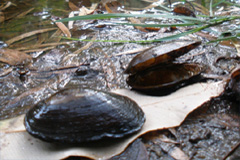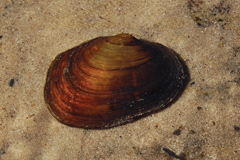Freshwater Mussels
Carters Freshwater Mussel
About Westralunio carteri
Westralunio carteri is South West WA’s only freshwater mussel. Because very little information on the biology, abundance and distribution of W. carteri exists, researchers at Murdoch University have begun work to identify the mussel’s life cycle and growth rates, environmental tolerances to salinity, temperature and drought, as well as updating and monitoring the species distribution and population information.
Freshwater mussels have important roles to play in river health. They feed by sucking water in through their ‘inhalent siphon’ and filtering out microscopic plankton, algae, bacteria and plant debris through their gills. They release clean, fresh water through their ‘exhalent siphon.’
Some scientists believe they have an especially important role in keeping a good standard of water quality in pools where freshwater fish retreat to over the dry, hot summer period.



Preferred habitat
Freshwater mussels can be found in freshwater streams, rivers, billabongs, ponds, wetlands and lakes inland from the coast. They are most common in areas with muddy, silty and sandy bottoms and flowing permanent water. Their shells are relatively smooth and elliptical in shape, helping them burrow into the stream bed. Tracks can be seen along banks and sandy/muddy patches of stream bed, where mussels have moved themselves along the bottom using a muscular tongue-like appendage known as a foot. Unlike their marine and estuarine cousins, they do not attach to structures. This allows them to move with receding water levels and position themselves to the best feeding spots.



Mussels in a forest pool, an urban stream bed, and in woody debris of a forest stream
Environmental tolerances
Environmental tolerances of W. carteri are not precisely known but they can be found where water temperatures range from 4°C to over 30°C. They require adequate amount of calcium and other minerals for the formation of their shells. A few studies of a New Zealand relative of W. carteri suggest a calcium requirement of at least 1 mg/L (Forsyth, 1978, Timperley, 1987). Laboratory experiments and field collection data suggest that W. carteri is intolerant of salinities above 3.0 g/L (Klunzinger et al., unpublished data). Recent work has shown that W. carteri is intolerant to dehydration for more than a few days (Klunzinger et al. , in review). In the summer of 2011, a large number of W. carteri died as a result of low dissolved oxygen (below 23%) and the influx of saltwater from the estuary in the Lower Canning River in the Perth area. Livestock and urban development projects have been known to crush shells and cause severe bank erosion which have contributed to species loss.



Damage caused by cattle can be seen in the foreground of the first two images above. The third image displays an example of controlled cattle access to river – increasing stream vegetation and helping mussels avoid being trampled.



Pristine, spring-fed freshwater mussel habitats
